Rurik dynasty
The Rurik dynasty (Belarusian: Ру́рыкавічы, romanized: Rúrykavichy; Russian: Рю́риковичи, romanized: Ryúrikovichi, IPA: [ˈrjʉrʲɪkəvʲɪt͡ɕɪ]; Ukrainian: Рю́риковичі, romanized: Riúrykovychi, IPA: [ˈrʲurɪkowɪtʃi]; literally "sons/scions of Rurik"), also known as the Rurikid dynasty or Rurikids, was a noble lineage founded by the Varangian prince Rurik, who established himself in Novgorod around the year AD 862.[1] The Rurikids were the ruling dynasty of Kievan Rus' (after the conquest of Kiev by Oleg of Novgorod in 882) before it finally disintegrated in the mid-13th century, as well as the successor Rus' principalities and Rus' prince republics of Novgorod, Pskov, Vladimir-Suzdal, Ryazan, Smolensk, Galicia-Volhynia (after 1199), Chernigov, and the Grand Duchy of Moscow (from 1263).
| Rurik dynasty Rurikids | |
|---|---|
| Royal dynasty | |
.png.webp) Personal seal of Yaroslav the Wise | |
| Country | |
| Founded | 862 (in Novgorod) |
| Founder | Rurik |
| Final ruler | Vasili IV of Russia |
| Titles |
Princely titles
|
| Style(s) |
|
| Estate(s) |
|
| Deposition | 1610 (in Moscow, Tsardom of Russia) |
| Cadet branches |
|
Following the disintegration of Kievan Rus', the most powerful state to eventually arise was the Grand Duchy of Moscow, initially a part of Vladimir-Suzdal, which, along with the Novgorod Republic, established the basis of the modern Russian nation.[2] Ivan III threw off the control of the Golden Horde and consolidated the whole of central and northern Rus', ruling it as "Prince of All Rus'".[3][4] Ivan IV assumed the title "Tsar of All Rus'" and transformed the state into the Tsardom of Russia. The Rurik line ruled until 1598, following which they were succeeded by the Romanovs after the Time of Troubles.[5]
The Romanovichi branch of the dynasty ruled southwestern Rus' and part of central Rus'. These territories were unified by Roman the Great and his son Daniel Romanovich, who was in 1253 crowned by Pope Innocent IV[6] as king of Galicia–Volhynia. After the line's extinction, the principality was annexed by Poland and Lithuania, and the title of its prince eventually passed to the ruler of Austro-Hungary. According to Ukrainian historiography continuous Rurikid sovereignty from the ninth century to the fourteenth represents part of Ukraine's historical process.[7] In Ukrainian historiography of the 19th century, Ukrainian historiographer Mykhailo Hrushevsky, who wrote a book under a similar name, referred to Rus' civilization as Ukraine-Rus'.[8] According to his studies Rus' is not considered to have ended in 1240, but merely to have shifted its centre slightly westward.[9][7]
As a ruling dynasty, the Rurik dynasty held its own in some parts of Rus' for a total of twenty-one generations in male-line succession, from Rurik (died 879) to Feodor I of Russia (died 1598), a period of more than 700 years. They are one of Europe's oldest royal houses, with numerous existing cadet branches.
Origins

The Rurikid dynasty was founded in 862 by Rurik, a Varangian prince. The scholarly consensus [10] is that the Rus' people originated in what is currently coastal eastern Sweden around the eighth century and that their name has the same origin as Roslagen in Sweden (with the older name being Roden).[11][12][13]
According to the prevalent theory, the name Rus', like the Proto-Finnic name for Sweden (*Ruotsi), is derived from an Old Norse term for "the men who row" (rods-) as rowing was the main method of navigating the rivers of Eastern Europe, and that it could be linked to the Swedish coastal area of Roslagen (Rus-law) or Roden, as it was known in earlier times.[14][15]
The name Rus' would then have the same origin as the Finnish and Estonian names for Sweden: Ruotsi and Rootsi.[15][16]
The Primary Chronicle gives the following account of how the Rurik dynasty began, dating it to the Byzantine years of the world 6368–6370 (AD 860–862):[17]
The tributaries of the Varangians drove them back beyond the sea and, refusing them further tribute, set out to govern themselves. There was no law among them, but tribe rose against tribe. Discord thus ensued among them, and they began to war one against another. They said to themselves, "Let us seek a prince who may rule over us and judge us according to the Law." They accordingly went overseas to the Varangian Russes: these particular Varangians were known as Russes, just as some are called Swedes, and others Normans, English, and Gotlanders, for they were thus named. The Chuds, the Slavs, the Krivichians, and the Ves' then said to the people of Rus', "Our land is great and rich, but there is no order in it. Come to rule and reign over us." They thus selected three brothers, with their kinsfolk, who took with them all the Russes and migrated. The oldest, Rurik, located himself in Novgorod; the second, Sineus, at Beloozero; and the third, Truvor, in Izborsk. On account of these Varangians, the district of Novgorod became known as the land of Rus'. The present inhabitants of Novgorod are descended from the Varangian race, but aforetime they were Slavs [преже бо бѣша Словѣни].
There is some ambiguity even in the Primary Chronicle about the specifics of the story, "hence their paradoxical statement 'the people of Novgorod are of Varangian stock, for formerly they were Slovenes.'" However, archaeological evidence such as "Frankish swords, a sword chape and a tortoiseshell brooch" in the area suggest that there was, in fact, a Scandinavian population during the tenth century at the latest.[18]
History

Rurik and his brothers founded a state that later historians called Kievan Rus′. By the middle of the twelfth century, Kievan Rus′ had dissolved into independent principalities, each ruled by a different branch of the Rurik dynasty. The dynasty followed agnatic seniority and the izgoi principle. The Rurik dynasty underwent a major schism after the death of Yaroslav the Wise in 1054, dividing into three branches on the basis of descent from three successive ruling Grand Princes: Izyaslav (1024–1078), Svyatoslav (1027–1076), and Vsevolod (1030–1093). In addition, a line of Polotsk princes assimilated themselves with the princes of Lithuania. In the 10th century the Council of Liubech made some amendments to a succession rule and divided Ruthenia into several autonomous principalities that had equal rights to obtain the Kievan throne.
Vsevolod's line eventually became better known as the Monomakhovichi and was the predominant one. The line of Svyatoslav later became known as Olegovychi and often laid claim to the lands of Chernihiv and Severia. The Izyaslavychi who ruled Turov and Volhynia were eventually replaced by a Monomakhovychi branch.

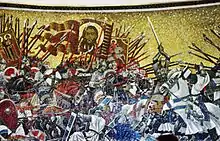
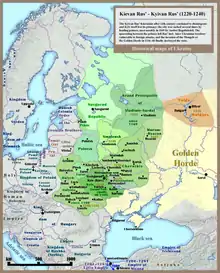
According to Jaroslav Pelenski,
The 'Riurikide' dynasty and the ruling elite ... attempted to impose on their highly diverse polity the integrative concept of russkaia zemlia ('the Rus' land') and the unifying notion of a 'Rus' people'. ... But 'Kievan Rus'' was never really a unified polity. It was a loosely bound, ill-defined, and heterogeneous conglomeration of lands and cities inhabited by tribes and population groups whose loyalties were primarily territorial.[20]
This caused the Rurik dynasty to effectively dissolve into several sub-dynasties ruling smaller states in the 10th and 11th centuries. These were the Olgoviches of Severia who ruled in Chernigov, Yuryeviches who controlled Vladimir-Suzdal, and Romanoviches in Galicia-Volhynia.[20][21]
Descendants of Sviatoslav II of Kiev
The Olgoviches descended from Oleg I of Chernigov, a son of Sviatoslav II of Kiev and grandson of Yaroslav the Wise. They continued to rule until the early 14th century when they were torn apart by the emerging Grand Duchy of Lithuania and Grand Duchy of Moscow. The line continued through Oleg's son Vsevolod II of Kiev, grandson Sviatoslav III of Kiev, great-grandson Vsevolod IV of Kiev and great-great-grandson Michael of Chernigov, from whose sons the extant lines of the Olegoviches are descended, including the Massalsky, Gorchakov, Baryatinsky, Volkonsky and Obolensky, including Repnin.
Descendants of Vsevolod I of Kiev
Vsevolod I of Kiev was the father of Vladimir II Monomakh, giving rise to the name Monomakh for his progeny. Two of Vladimir II's sons were Mstislav I of Kiev and Yuri Dolgorukiy.
The Romanoviches (Izyaslavichi of Volhynia) were the line of Roman the Great, descended from Mstislav I of Kiev through his son Iziaslav II of Kiev and his grandson Mstislav II of Kiev, father of Roman the Great. The older Monomakhovychi line that ruled the Principality of Volhynia were eventually crowned kings of Galicia and Volhynia and ruled until 1323. The Romanovychi displaced the older line of Izyaslavychi from Turov and Volhynia as well as Rostyslavychi from Galicia. The last were two brothers of Romanovychi, Andrew and Lev II, who ruled jointly and were slain trying to repel Mongol incursions. The Polish king, Władysław I the Elbow-high, in his letter to the Pope wrote with regret: "The two last Ruthenian kings, that had been firm shields for Poland from the Tatars, left this world and after their death Poland is directly under Tatar threat." Losing their leadership role, the Rurikids, however, continued to play a vital role in the Grand Duchy of Lithuania and the later Polish–Lithuanian Commonwealth. Most notably, the Ostrogski family held the title of Grand Hetman of Lithuania and strove to preserve the Ruthenian language and Eastern Orthodoxy in this part of Europe. It is thought that the Drutsk and related princely families may also descend from Roman the Great.
The Rostislaviches were the line of Rostislav I of Kiev, another son of Mstislav I of Kiev, who was Prince of Smolensk and a progenitor of the lines descending from the princes of Smolensk and Yaroslavl.
The Shakhovskoys were founded by Konstantin "Shakh" Glebovich, Prince of Yaroslavl, and traces its lineage to Rostislav I of Kiev through his son Davyd Rostislavich. This branch also descends cognatically of Ivan I of Moscow, through the latter's daughter Evdokia Ivanovna Moskovskaya (1314–1342),[22] who married Vasili Mikhailovich, Prince of Yaroslavl (died 1345).[23] They were the great-grandparents of Andrey and Yuriy, the first Shakhovskoy princes. This is possibly the most senior extant branch of the Rurikids, with many Shakhovskoys living outside of Russia after having fled during the Russian Revolution.
The Yuryeviches were founded by Yuriy Dolgorukiy, the founder of Moscow and spread vastly in the north-east. Yuri's son Vsevolod the Big Nest was Prince of Vladimir-Suzdal, a precursor state to the Grand Principality of Moscow and thus of the Russian Empire. Vsevolod's son Konstantin of Rostov was Prince of Rostov and the progenitor of various Rostov princely lines. Another son, Ivan Vsevolodich, was Prince of Starodub and progenitor of a number of extant lines, most notably the Gagarin line.
Vsevolod's son Yaroslav II of Vladimir was the father of Alexander Nevsky, whose son Daniel of Moscow sired the ruling house of Moscow until the end of the 16th century.
Beginning with the reign of Ivan the Terrible, the Muscovite branch used the title "Tsar of All Russia" and ruled over the Tsardom of Russia. The death in 1598 of Tsar Feodor I ended the rule of the Rurik dynasty. The dynasty was briefly revived in the person of Vasili IV of Russia, a descendant of Shuyskiy line of the Rurik dynasty, but he died without issue. The unstable period known as the Time of Troubles followed Feodor's death and lasted until 1613.
In that year, Mikhail I ascended the throne, founding the Romanov dynasty that would rule until 1762 and as Holstein-Gottorp-Romanov until the revolutions of 1917. Tsar Mikhail's father Patriarch Filaret of Moscow was descended from the Rurik dynasty through the female line. His mother, Evdokiya Gorbataya-Shuyskaya, was a Rurikid princess from the Shuysky branch, daughter of Alexander Gorbatyi-Shuisky. Tsar Mikhail's first wife Maria Dolgorukova was of Rurikid stock but their marriage produced no children. Emperor Peter III in 1762 brought fresh Rurikid blood to the Romanovs: he and his wife Catherine the Great both descended from the Rurik dynasty. (Catherine the Great descended from a daughter of Yaroslav I (978–1054) through her maternal grandfather, Christian August of Holstein-Gottorp.[24])
Trade
In the early days of the Rurikid dynasty, the Kievan Rus' mainly traded with other tribes in Eastern Europe and Scandinavia. "There was little need for complex social structures to carry out these exchanges in the forests north of the steppes. So long as the entrepreneurs operated in small numbers and kept to the north, they did not catch the attention of observers or writers." The Rus' also had strong trading ties to Byzantium, particularly in the early 900s, as treaties in 911 and 944 indicate. These treaties deal with the treatment of runaway Byzantine slaves and limitations on the amounts of certain commodities such as silk that could be bought from Byzantium. The Rus' used log rafts floated down the Dnieper River by Slavic tribes for the transport of goods, particularly slaves to Byzantium.[25]
Skirmish with Byzantium
One of the largest military accomplishments of the Rurikid dynasty was the attack on Byzantium in 960. Pilgrims of the Rus' had been making the journey from Kiev to Constantinople for many years, and Constantine Porphyrogenitus, the Emperor of the Byzantine Empire, believed that this gave them significant information about the arduous parts of the journey and where travelers were most at risk, as would be pertinent for an invasion. This route took travelers through domain of the Pechenegs, journeying mostly by river. In June 941, the Rus' staged a naval ambush on Byzantine forces, making up for their smaller numbers with small, maneuverable boats. These boats were ill-equipped for the transportation of large quantities of treasure, suggesting that looting was not the goal. The raid was led, according to the Primary Chronicle, by a king called Igor. Three years later, the treaty of 944 stated that all ships approaching Byzantium must be preceded by a letter from the Rurikid prince stating the number of ships and assuring their peaceful intent. This not only indicates fear of another surprise attack, but an increased Kievan presence in the Black Sea.[26]
Legacy
Russian and Ukrainian historians have debated for many years about the legacy of the Rurikid dynasty. The Russian view sees the Principality of Moscow ruled by the Rurikid dynasty as the sole heir to the Kievan Rus' civilization, this view is "resting largely on religious-ecclesiastical and historical claims" because Russia was ruled by the Rurikid dynasty until 16th century, while Ukraine was not defined as a state until 20th century. This view started in Moscow as ruled by the original Rurikid dynasty between the 1330s and the late 1850s. The Ukrainian view was formulated much later, between the 1840s and the end of the 1930s in Eastern Austria, and views the Ukrainian descendants of the Rurikid dynasty as its only true successors. The Soviet theory was a modified version of the Russian which "allotted equal rights to the Kievan inheritance to the Three Slavic peoples, that is the Russians, the Ukrainians, and the Belorussians",[27] but later elevated the Russian nation as the elder brother to give the others "needed guidance in revolutionary struggles and socialist construction."[28]
There are currently various extant branches of the Rurikids, for instance: the Houses of Shakhovskoy, Gagarin, and Lobanov-Rostovsky. Whose some of the representatives are: Prince Dmitriy Mikhailovich Shakhovskoy (born 1934), Prince Dmitri Andreevich Gagarin (born 1973) and Prince Nikita Lobanov-Rostovsky (born 1935), a descendant of Prince Konstantin Vasilyevich of Rostov. The three of them are of the Monomakhovichi branch.[29] While the Shakhovskoys claim descent from Mstislav I of Kiev, the Gagarins, and the Lobanov-Rostovskys are descendants of Vsevolod III of Vladimir, which makes the Shakhovskoys the most senior.
Branches
- Izyaslavichi of Polotsk, princes of Polotsk
- Izyaslavichi of Turov, princes of Turiv and Volhynia
- Monomakhovichi, princes of Pereyaslav
- Izyaslavichi of Monomakh, princes of Volhynia, kings of Rus (senior branch)
- Rostislavichi, princes of Smolensk (middle branch)
- Yurievichi, princes of Vladimir-Suzdal, Grand Princes of Moscow (junior branch)
- Shakhovskoy, princes of Yaroslavl (senior extant branch)
- Lobanov-Rostovsky, princes of Rostov (middle extant branch)
- Gagarin, princes of Starodub-on-the-Klyazma (junior extant branch)
- Khilkov, princes of Starodub-on-the-Klyazma (junior extant branch)
- Mosalsky, princes of Mosalsky (Massalsky)
- Olgovichi, princes of Chernihiv
- Rostislavichi of Halych, princes of Halych
- Kropotkin, princes Kropotkin (extant)
- Rzhesvsky, non-titled (extant)
- Putyatin, princes Putyatin (extant)
- Obolensky, princes Obolensky (extant)
- Dolgorukov, princes Dolgorukov (extant; cadet branch of the Obolensky family)
- Gorchakov, princes Gorchakov (extant)
- Vadbosky, a branch of the princes Belozersky (extant)
- Volkonsky, a branch of the princes of Tarusa (extant)
- Possibly the Wiśniowiecki family, a branch of the House of Zbaraski (extinct)[30]
Family tree (from Rurik to Vladimir I)
| Rurik | Efanda of Novgorod | ||||||||||||||||||||||||||||||||||||||||||||||||||||||||||
| Igor of Kiev | Olga of Kiev | Malk Lubchanin | |||||||||||||||||||||||||||||||||||||||||||||||||||||||||
| Predslava | Sviatoslav I | Malusha | Rogvolod | Dobrynya | |||||||||||||||||||||||||||||||||||||||||||||||||||||||
| Oleg | Yaropolk I | Greek nun | Anna Porphyrogenita | Vladimir I the Great | Rogneda of Polotsk | Konstantin Dobrynich | |||||||||||||||||||||||||||||||||||||||||||||||||||||
| daughter of Bolesław I Chrobry | Sviatopolk I | Theofana | 8 issues (see below) | Dobrynich line | |||||||||||||||||||||||||||||||||||||||||||||||||||||||
Wives and children of Vladimir I (1)
| Olof Skötkonung | Estrid of the Obotrites | Rogneda of Polotsk | Vladimir I the Great | Adela | |||||||||||||||||||||||||||||||||||||||||||||||||||||||||||||||||||||||||||||||||||||||||||||||||||||
| Saint Anna | Yaroslav the Wise | Izyaslav of Polotsk | Mstislav | Vsevolod | Premislava | Mstislava | Predslava | Mstislav of Chernigov | Boris | Gleb | Stanislav | Sudislav | |||||||||||||||||||||||||||||||||||||||||||||||||||||||||||||||||||||||||||||||||||||||||||||
| 10 children | Polotsk line | Eustaphius | |||||||||||||||||||||||||||||||||||||||||||||||||||||||||||||||||||||||||||||||||||||||||||||||||||||||
Wives and children of Vladimir I (2)
| Olava | Vladimir I the Great | Malfrida | |||||||||||||||||||||||||||||||||||
| Vysheslav | Sviatoslav | ||||||||||||||||||||||||||||||||||||
Wives and children of Vladimir I (3)
| granddaughter of Otto I the Great | Vladimir I the Great | unknown mistress | |||||||||||||||||||||||||||||||||||||||
| Casimir I duke of Poland | Maria Dobroniega | Bernard margrave of Nordmark | out-of-wedlock daughter | Pozvizd | |||||||||||||||||||||||||||||||||||||
Yurievich branch
The following shows the descent of the leading (historically most powerful) branch of the Russian Rurikids, being the descendants of Yuri I Dolgorukiy ("Long-Armed"), sixth son of Vladimir II Monomakh:
- Vladimir the Great
- Yaroslav the Wise, son of Vladimir I the Great
- Vsevolod I of Kiev, son of Yaroslav the Wise
- Vladimir II Monomakh, son of Vsevolod I of Kiev
- Yuri I Dolgorukiy, son of Vladimir II Monomakh
The lineage from Yuri I onwards is given in the table below
Family tree
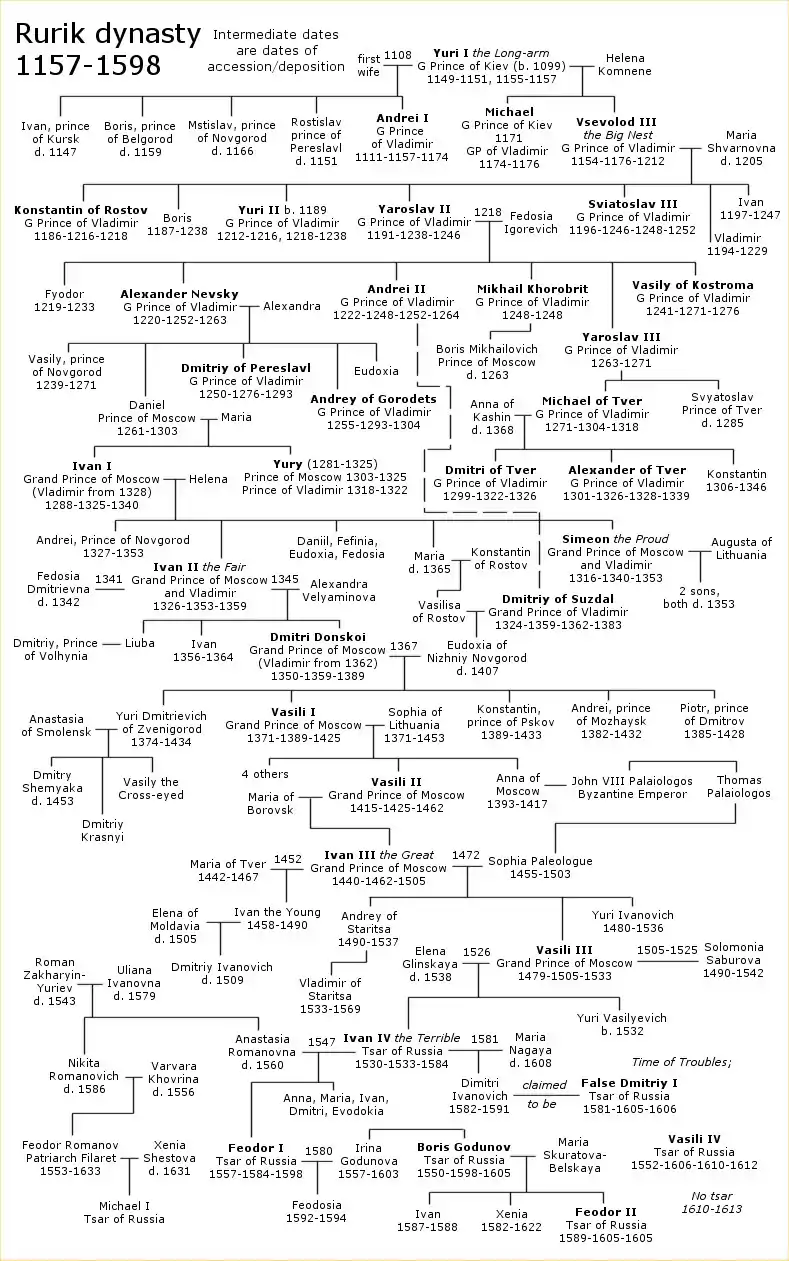
Gallery
 Arms of the House of Holstein-Gottorp-Romanov
Arms of the House of Holstein-Gottorp-Romanov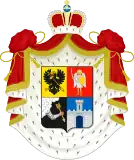 Coat of arms of the Dolgoruky family
Coat of arms of the Dolgoruky family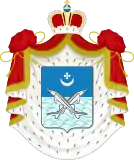 Coat of arms of the Belosselsky-Belozersky family
Coat of arms of the Belosselsky-Belozersky family Coat of arms of the Kropotkin family
Coat of arms of the Kropotkin family Coat of arms of the families of Monastyrev stock is composed of Smolensk and Belozersk emblems.
Coat of arms of the families of Monastyrev stock is composed of Smolensk and Belozersk emblems. Gagarin family / Khilkoff Coat of arms
Gagarin family / Khilkoff Coat of arms Coat of arms of the Golitsyn family
Coat of arms of the Golitsyn family Coat of arms of the Gorchakov family
Coat of arms of the Gorchakov family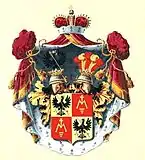 Coat of arms of the Mosalsky family
Coat of arms of the Mosalsky family Coat of arms of the Ostrogski family
Coat of arms of the Ostrogski family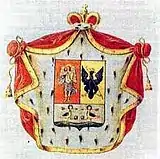
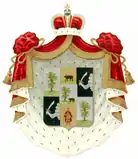 Coat of arms of the Romodanowski family
Coat of arms of the Romodanowski family Coat of arms of the Shuyski family
Coat of arms of the Shuyski family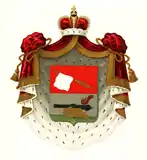 Coat of arms of the Tatischev family
Coat of arms of the Tatischev family Korybut coat of arms
Korybut coat of arms
See also
- Rulers of Kievan Rus'
- Shum Gora
- Grand Prince of Tver
- Knyaz
- Symbols of the Rurikids
References
- Rurik Dynasty (medieval Russian rulers) Britannica Online Encyclopedia
- Excerpted from Glenn E. Curtis, ed. (1998). "Russia: A Country Study: Kievan Rus' and Mongol Periods". Washington, D.C.: Federal Research Division of the Library of Congress. Archived from the original on 27 September 2007. Retrieved 20 July 2007.
- Grey, Ian (1972) [1964]. Ivan III and the Unification of Russia (2nd ed.). English Universities Press. ASIN B004GV3YAM.
- May, T. "Khanate of the Golden Horde". accd.edu. Archived from the original on 7 June 2008. Retrieved 27 December 2007.
- "Rurik Dynasty Lays Claim to Kremlin". The Moscow Times. 16 June 2010. Retrieved 24 October 2022.
- Maiorov, A.V. "The Imperial Purple of the Galician-Volynian Princes" (PDF) (in Russian). 94 (47): 147–161. doi:10.17223/18572685/36/8.
{{cite journal}}: Cite journal requires|journal=(help) - Paul Robert Magocsi (2010). A History of Ukraine: The Land and Its People (2nd ed.). Toronto: University of Toronto Press. pp. 23–24. ISBN 978-1-4426-4085-6. OL 26883003M. Wikidata Q105635025.
- "Mykhaylo Hrushevsky | Ukrainian historian | Britannica". www.britannica.com. Retrieved 15 November 2021.
- Andrew Wilson (2015). The Ukrainians: Unexpected Nation (4th ed.). New Haven: Yale University Press. p. 2. ISBN 978-0-3002-1725-4. LCCN 2009934897. OCLC 1041258081. OL 29278318M. Wikidata Q106528132.
- "The Vikings at home". HistoryExtra. Retrieved 24 May 2020.
- "Kievan Rus". World History Encyclopedia. Retrieved 24 May 2020.
- "The Vikings (780–1100)". www.metmuseum.org. Retrieved 24 May 2020.
- "Viking Tours Stockholm, 20 Historical Cultural Transported Tours". Sweden History Tours. Retrieved 24 May 2020.
- Blöndal, Sigfús (1978). The Varangians of Byzantium. Cambridge University Press. p. 1. ISBN 9780521035521.
- Stefan Brink, 'Who were the Vikings?', in The Viking World, ed. by Stefan Brink and Neil Price (Abingdon: Routledge, 2008), pp. 4–10 (pp. 6–7).
- "Russ, adj. and n." OED Online, Oxford University Press, June 2018, www.oed.com/view/Entry/169069. Retrieved 12 January 2021.
- The Russian Primary Chronicle, translated by Samuel Hazzard Cross and Olgerd Sherbowitz-Wetzor, pp. 59–60. For original, see here.
- Franklin, Simon, and Jonathan Shepherd. The Emergence of Rus 750–1200. Harlow, Essex: Longman Group, Ltd., 1996. pp. 38–39.
- Zhukovskyi, Arkadii (1 December 2009). "Encyclopedia of Ukraine". Entsykpopedychnyi Visnyk Ukrainy [The Encyclopedia Herald of Ukraine]. 1: 14–22. doi:10.37068/evu.1.2. ISSN 2707-000X.
- Pelenski, Jaroslaw. The Contest for the Legacy of Kievan Rus. New York: Columbia University Press, 1998. p. 4
- Raffensperger, Christian, and Norman W. Ingham, "Rurik and the First Rurikids", The American Genealogist, 82 (2007), 1–13, 111–119.
- Averyanov K. Principality of Moscow under Ivan Kalita (Accession of Koloman. Acquisition of Mozhaisk). – M., p. 36, 1994.
- Voronov, A. A. (2009). "Orthodox monastery in the forest". Монастыри московского кремля [Monasteries of the Moscow Kremlin] (in Russian). Saint Tikhon's Orthodox University for the Humanities. ISBN 978-5-7429-0350-5.
- "Родословная Екатерины II Великой, российской императрицы 1729–1796" [Ancestry of Catherine II the Great, Russian Empress 1729–1796]. Russia Today (in Russian). Retrieved 17 March 2022.
- Franklin, Simon, and Jonathan Shepherd (1996). The Emergence of Rus 750–1200. Harlow, Essex: Longman Group, Ltd., pp. 27–28, 127.
- Franklin, Simon, and Jonathan Shepherd (1996). The Emergence of Rus 750–1200. Harlow, Essex: Longman Group, Ltd. pp. 112–119
- Pelenski, Jaroslaw Pelenski (1998). The Contest for the Legacy of Kievan Rus'. New York: Columbia University Press. p. 2.
- Serhy Yekelchyk (2007), Ukraine: Birth of a Modern Nation (1st ed.), Oxford: Oxford University Press, p. 9, Wikidata Q106457257
- Manaev, G. (8 July 2019). "Who founded Russia and ruled it before the Romanovs". Russia Beyond the Headlines. Retrieved 29 January 2020.
- Jerzy Jan Lerski; Piotr Wróbel; Richard J. Kozicki (1996). Historical Dictionary of Poland, 966–1945. Greenwood Publishing. p. 654. ISBN 978-0-313-26007-0.
Further reading
- Bibliography of the history of the Early Slavs and Rus'
- Bibliography of Russian history (1223–1613)
- List of Slavic studies journals